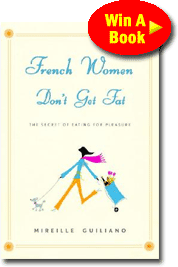|
|
(back to page 5)
DR. MIRACLE'S PRESCRIPTION
For the next three weeks, I was to keep a diary of "everything" I ate. This is a strategy that will sound familiar from some American diet programs, such as Weight Watchers. I was to record not only what and how much, but also when and where. There was no calorie counting, not that I could have done that. The stated purpose was simply for him to gauge the "nutritional" value of what I was eating (it was the first time I ever heard the word). Since nothing more was asked of me, I was only too happy to comply. This is the first thing you should do, too.
Dr. Meyer demanded no great precision in measurement. Just estimate, he said, stipulating "a portion" as the only unit of quantity and roughly equal to a medium-size apple. In America, where the greatest enemy of balanced eating is ever-bigger portions, I suggest a little more precision. Here's where the small kitchen scale comes in. (Bread, which sometimes comes in huge slices here, might be more easily weighed than compared with an apple, which seems bigger here, too!)
Three weeks later, I was home again for the weekend. Just before noon, Dr. Miracle, distingue, gray templed, made his second house call. He also stayed for lunch. Afterward, reviewing my diary, he immediately identified a pattern utterly obvious to him but hiding somehow from me, as I blithely recorded every crumb I put in my mouth. On the walk between school and the room I was renting in the Seventh Arrondissement, there were no fewer than sixteen pastry shops. Without my having much noticed, my meals were more and more revolving around pastry. As I was living in Paris, my family could not know this, so when I came home, my mother naturally prepared my favorites, unaware I was eating extra desserts on the sly, even under her roof.
My Parisian pastry gluttony was wonderfully diverse. In the morning there was croissant or "pain au chocolat" or "chouquette" or "tarte au sucre." Lunch was preceded by a stop at Poilane, the famous breadmaker's shop, where I could not resist the "pain aux raisins" or "tarte aux pommes" (apple tart) or "petits sables." Next stop was at a cafe for the ubiquitous "jambon-beurre" (ham on a buttered baguette) and what remained of the Poilane pastry with coffee. Dinner always included and sometimes simply was an eclair, "Paris Brest, religieuse," or "mille-feuille" (curiously called a napoleon outside France), always some form of creamy, buttery sweetness. Sometimes I would even stop off for a "palmier" (a big puff pastry sugar-covered cookie) for my "gouter" (afternoon snack). As a student, I was living off things I could eat on the go. Hardly any greens were passing my lips, and my daily serving of fruit was coming from fruit tarts. I was eating this strangely lopsided fare without the slightest thought and with utter contentment—except, of course, for how I looked.
Now this was obviously not a diet I had picked up in America, where one could hardly say the streets are lined with irresistible patisseries (though then, as now, there was no shortage of tempting hot chocolate-chip cookie stands and sellers of rich ice cream, to say nothing of a mind-boggling variety of supermarket sweets made with things infinitely worse for you than cream and butter). But as I was to learn, it was my adoptive American "way" of eating that had gone to my head and opened me up to the dangers of this delicious Parisian minefield. For in America, I had gotten into some habits: eating standing up, not making my own food, living off whatever ("n'importe quoi," as the French say), as other kids were doing. Brownies and bagels were particular hazards; we had nothing quite like them at home, so who could tell how rich they were?
Back in France, I continued to eat "n'importe quoi," though there were no brownies to be found. Perhaps I missed my adoptive second home and was searching for my madeleine—remembrance of sweets past. In any case, I became very free and easy with all the goodies France had to offer. Finally, I was a "mille-feuille" junkie. Like an addict's, my body came to expect too much of what had once been blissfully intoxicating in small doses.
It was time to enter rehab, but fortunately Dr. Miracle had never heard of cold turkey. (The French don't much care for "dinde" at any temperature.)
Dr. Miracle's approach was much less confrontational and more civilized. According to him, there are two selves in each of us: the one who wants to be slim and healthy and the one who wants something else. One sees the big picture—well-being, self-esteem, fitting into the latest fashions. The other wants pleasures aplenty, and now. One is Narcissus leaning over his pool; the other is Pantagruel leaning over his table. The key, he said, was not to conquer the second, but to broker a rapprochement: make friends of your two selves and be the master of both your willpower "and" your pleasures. That was the French way.
(This excerpt ends on page 23.)
If you’re enjoying this excerpt and you’d like to sample other books, join our Online Book Clubs.
|
|

|